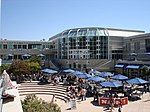San Diego Supercomputer Center

The San Diego Supercomputer Center (SDSC) is an organized research unit of the University of California, San Diego (UCSD). SDSC is located at the UCSD campus' Eleanor Roosevelt College east end, immediately north the Hopkins Parking Structure. The current SDSC director is Michael L. Norman, UCSD physics professor, who succeeded noted grid computing pioneer Francine Berman. He was named director September 2010, having been interim director more than a year. SDSC was founded in 1985 and describes its mission as "developing and using technology to advance science." The SDSC was one of the five original NSF Supercomputing Centers and the National Science Foundation (NSF) continues to be a primary funder of the SDSC. Its research pursuits are high performance computing, grid computing, computational biology, geoinformatics, computational physics, computational chemistry, data management, scientific visualization, and computer networking. SDSC computational biosciences contributions and earth science and genomics computational approaches are internationally recognized.
Excerpt from the Wikipedia article San Diego Supercomputer Center (License: CC BY-SA 3.0, Authors, Images).San Diego Supercomputer Center
Ridge Walk, San Diego Torrey Pines
Geographical coordinates (GPS) Address Website External links Nearby Places Show on map
Geographical coordinates (GPS)
| Latitude | Longitude |
|---|---|
| N 32.884437 ° | E -117.239465 ° |
Address
San Diego Supercomputer Center
Ridge Walk
92093 San Diego, Torrey Pines
California, United States
Open on Google Maps




